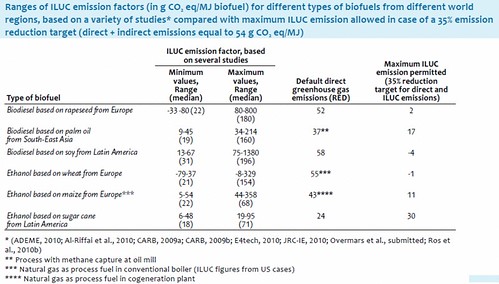The EU Commission’s report on indirect land use change related to biofuels and bioliquids released just before Christmas has made the continuation of the EU’s renewable energy in transport targets extremely problematic. Indeed, it is hard to see how this policy can survive in the New Year without some extremely clever footwork by the Commission.
Further studies recommended
The report was mandated by the Directives setting out the EU’s renewable energy targets, which required the Commission to review the impact of indirect land use change on greenhouse gas emissions and to address ways to minimise that impact, including proposing a concrete methodology to incorporate emissions from carbon stock changes caused by indirect land-use change.
After a two-year investigation, the Commission report has accepted that indirect land use change (ILUC) will reduce carbon savings from biofuels, but it stopped short of immediately recommending new barriers against unsustainable biofuels. Instead, it has delayed the announcement of its biofuels strategy for a further six months in order to undertake additional studies.
During this period it proposes to finalise its impact assessment, focusing on the following four policy options:
(1) take no action for the time being, while continuing to monitor,
(2) increase the minimum greenhouse gas saving threshold for biofuels,
(3) introduce additional sustainability requirements on certain categories of biofuels,
(4) attribute a quantity of greenhouse gas emissions to biofuels reflecting the estimated
indirect land-use impact.
Sustainability criteria
A close reading of the report, in conjunction with the Commission’s existing sustainability criteria, suggests that it will be hard to defend the existing mandatory targets by 2020. The report does not explicitly conclude, as some critics have alleged, that the biofuels policy could actually increase global GHG emissions once ILUC is factored in, but that appears to be implied and it certainly suggests that achieving the existing sustainability criteria will be extremely difficult.
The sustainability criteria adopted by the Commission last June aim at preventing the conversion of areas of high carbon stock and high biodiversity for the production of raw materials for biofuels. They also require biofuels to achieve minimum greenhouse gas emission savings of 35% compared to fossil fuels. This requirement is progressive as it increases to 50% in 2017 and 60% in 2018 for new installations.
As the EU reference figure for GHG emissions from transport fuel is 83.8 kg CO2eq/GJ, this implies that emissions from a sustainable biofuel cannot exceed 54.3 kg CO2eq/GJ in the short term.
Factoring in indirect land use change
ILUC can never be observed, thus calculations of its extent must depend on modelling which is inherently uncertain. The EU report is based on a comprehensive literature review of existing model results, as well as two original modelling exercises. One exercise was undertaken by IPTS (the Commission’s in-house research unit) and uses the AGLINK-COSIMO model which the Commission uses for its medium-term market forecasts. The other exercise was undertaken by IFPRI using the MIRAGE model.
The report contains a table comparing the ILUC emissions for a specific biofuel pathway (maize-ethanol). Ignoring the two outliers, the emissions are concentrated in the range 40-50 kg CO2eq/GJ.
Using a specially developed land conversion module (which essentially shows where the new crop land will come from, taking into account land suitability and distance from existing cultivated areas), the Commission report calculates the GHG emissions from its two independent modelling exercises, assuming scenarios based on incorporating around 8.5% conventional biofuels in transport fuel. It finds that emissions would be 64 kg/GJ for AGLINK-COSIMO, and 34-41 kg/GJ for the IFPRI MIRAGE central scenario.
Assume that the Commission, after its six months reflection, finds that the appropriate quantity of GHG emissions to attribute to ILUC is, say, 45 kg CO2eq/GJ (it would not be appropriate to have a single value given different feedstocks and producing regions, but we use this for illustration). Under its own criteria that biofuels can only count towards the renewables target if they show a GHG saving of at least 35% relative to fossil fuels, then only biofuels with a lifecycle emissions of less than 9 kg/GJ excluding ILUC (54 – 45 kg/GJ) would be eligible. This would exclude the vast majority of current biofuels and would require, if not the scrapping, at least the postponement of the current 10% renewables in transport fuels target.
If the biofuel targets are suspended, at least until second-generation biofuel technology is fully commercialised, this will have a perceptible dampening effect on the outlook for some agricultural prices for the rest of this decade.
UPDATE 30 Dec 2010
Since writing this I have come across a report prepared by researchers at the Netherlands Environmental Assessment Agency as an input to the Commission’s public consultation on ILUC, and which makes the same point that I make in this post from a different perspective. Using the default GHG emission factors in the Renewable Energy Directive, it has prepared a table showing how much ‘headroom’ would be left for ILUC emissions if the Commission’s sustainability criteria were to be met. As can be seen from the table below, the available headroom is well below any realistic ILUC value. It concludes that “Most biofuels with ILUC effects do not fit into a long-term perspective with an 80 to 95% reduction in greenhouse gas emissions. Other technical options, without ILUC effects, such as advanced biofuels and zero-emission vehicles, do.”

Note: Front image copyright Chris Upson http://www.geograph.org.uk/profile/2067 and licensed for reuse under Creative Commons licence 2.0.

